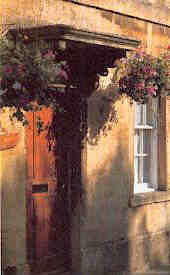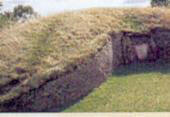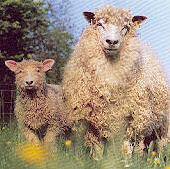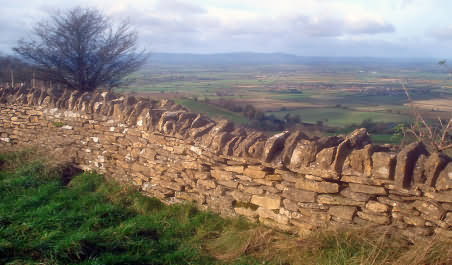 |
| The Local Time is Saturday, 27-Jul-2024 12:37:01 CEST |
The Cotswolds History & Heritage of Wool & Stone |
|
|||
| YOU ARE HERE: Main Home Page > Home Page > History & Heritage |
|
|
|
|
|
|
|
|
 |
|||||||||||||||||||||||
|
Cotswolds History & Heritage | ||||||||||||||||||||||
The Wool Trade'In Europe the best wool is English and in England the best wool is Cotswold' In the Middle Ages the Cotswolds was well known throughout Europe as the source of some of the best wool. The Cotswolds were ideal for sheep so the Abbeys and monasteries raised huge flocks of the 'Cotswold The world-famous row of cottages at Arlington Row, Bibury was originally constructed 600 years ago as a factory for processing wool. In the 18th century cloth manufacture became centred on the Stroud valleys where there was plenty of waterpower, and at its height there were about 150 mills. Many still exist today, although, used for other purposes. William Camden in 1610 wrote as part of his great work Britannia, a topographical and historical survey of all of Great Britain ........
In these Woulds there feed in great numbers, flockes of sheepe long necked and square of bulke and bone, by reason (as it is commonly thought) of the weally and hilly situation of their pasturage; whose |
|||||||||||||||||||||||
Buried in WoolFrom early times England was noted for her woolen products and home grown wool was a major part of the national wealth. During the 14th and 15th centuries the protection of this national product was of great importance, and an act was passed in the reign of King Charles II for the express purpose of increasing the consumption of English wool. Subsequent to the BURIAL IN WOOL ACTS 1667 and 1678 all bodies were to be buried in wool only, unless they have died from the Plague and an affidavit sworn accordingly. The penalty for not doing so was £5. These were repealed in 1814. It was decreed that: "No corps should be buried in anything other than what is made of sheep's wool only; or put into any coffin lined or faced with any material but sheep's wool, on pain of forfeiture of £5." In addition, an affidavit to that effect was required not later than 8 days after the burial. The following transcripts (although not unique) were found in the Rothbury Parish Register. "Elizab. Litster, Late of Low Trewitt, deceased, ye 2nd daughter of Edward Litser was buried in nothing but wooling accordyng to ye Act on ye behalf, as does appear by ye affidavit made by Edward Litster and John Vint to Mr. Thom. Collingwood, one of his Majs. Justice of ye Peace, and his certificate under his hand bearing date ye 2nd of 7br., 1678." "Mary Storrey, of ye Craghead, was wrapt or wound up in nothing but woollen accdng to Stat. on ye behalfe, as appears by Affidavit made by Robt. Storry, ibid, to r. Thom. Hursley, in his certificate under his hand, bearing date ye 5th day 5br., 1678"
|
|||||||||||||||||||||||
The StoneThe Cotswolds are very rich in Oolitic (meaning egg stone from the Greek) Limestone and so it was natural to start building with it in the Middle Ages due to its propensity and comparative cheapness. There are still a good few quarry's in the region still extracting and working the stone for repairs and the construction of new buildings. The old limestone houses and cottages are invariably 'Listed' buildings which means they are tightly projected by the authorities from alteration from the original and any new buildings invariably have to be built of limestone with matching roof pitches of 60 degrees. The colour of the stone of the 'chocolate box' villages does vary depending on the location of where it was quarried. Generally, in the northern part of the Cotswolds the stone is a beautiful 'honey golden brown' and the further south towards the city of Bath the stone becomes 'creamier' in colour. The Cotswolds has more specially protected or 'listed' buildings of any other region. J. B. Priestley wrote of Cotswold stone that - "the truth is that it has no colour that can be described. Even when the sun is obscured and the light is cold, these walls are still faintly warm and luminous, as if they knew the trick of keeping the lost sunlight of centuries glimmering about them." Walk or drive around Cotswold villages and towns for even a day, and you will know what he meant. In the Oxfordshire Cotswolds the quarry at Taynton, near Burford, had a reputation for high quality stone. In the 13th century large quantities of creamy Taynton Stone was transported to Oxford for use on its colleges and later at Eton College, Windsor Castle and Blenheim Palace. The Radcliffe Camera building at Oxford was built using both Taynton and Burford limestone. On the southern edge, the quarries at Corsham supplied the famous Bath stone used in the city. Stone from Minchinhampton was used for the Houses of Parliament and that from Leckhampton was used to build Cheltenham. The most important centre for the supply of Roofing Stones was the village of Stonesfield (between Charlbury and Woodstock) where the villagers laid out the wet limestone in winter for the frosts to naturally split the stone. The Cotswold village of Naunton also used to be a centre for the production of stone roofing slates. At one time 30,000 slates a week were dug from the thin stone seams in nearby mines. |
 |
||||||||||||||||||||||
The Land |
|||||||||||||||||||||||
Salt Ways These ancient routes radiated from Droitwich in varying directions with the ways going in or around Worcester to travel south and to the West, the means used were by uses of the rivers, oxcart or packhorse. Salt has numerous uses , paper, soaps, setting of dyes in textiles, in medicine its uses in healing played an important role through the ages, it is used in the manufacture of many commodities and has been for many thousands of years so the importance of its transportation through the centuries has played a large part in the construction of the roadway system. A route for the distribution of salt is believed to have been,
Worcester, Elmley Castle, Ashton under Hill, Dumbleton, Toddington,
Hailes, Winchcombe, Stow-on-The-Wold,
Salperton, Coln St. Aldwyn, Lechlade,
and through to the coast in Hampshire, Winchcombe was very much
a crossroads for trading routes. It was something that was smuggled and therefore attracted attention of the revenue men. |
|||||||||||||||||||||||
Coaching RoutesStage Coaches were in general use from the mid 17th century for about 200 years, with coaching inns or what was known as Staging Inns usually spaced some 7 miles apart, many offered very basic facilities whilst others had a blacksmith or a wheelwright attached to their premises or in close vicinity. It was accepted that whilst there were empty beds available inns could continue serving drinks which meant almost 24 hour drinking, wayfarers and stragglers were acceptable. Coaching routes through the Cotswolds generally followed the Roman Roads, Broadway was on the main route to London from Worcester and was an important staging point, Fish Hill was a steep climb for horses so frequently additional horses needed to be hitched to the coaches. As it was a much frequented stopping place it was a place of many staging inns, it has been said that at one time there was as many as 40 places offering accommodation for coach travellers. |
|||||||||||||||||||||||
Silk ProductionAt the time of James 1st the production of silk was encouraged, it was he who was responsible for the planting of the white mulberry (the black mulberry does not attract the silk worm) on what is now the site of Buckingham Palace, however the gardens became a meeting place of women of ill-repute and his dreams of the gardens being important in the production of silk were dashed. Silk was an important part of the Cotswolds industry, with mills being in many Cotswold locations amongst them being Winchcombe, Blockley and Broadway. The mill in Broadway was established by a Mr.Mann in 1810 but closed in 1864, the remains still stand near West End farm. References to silk are still to be found in different places - i.e Silk Lane at Winchcombe amongst them. There were other types of mills in and around Broadway, it is mentioned that in 1291 there were 2 mills in the manor of Broadway, in 1454 a Fulling Mill existed, in 1528 Broadway Mill was rented by a William Hannow. In 1575 there were 2 water mills belonging to the manor but by 1640 they belonged to a family by the name of Savage who owned middle hill estate, it was still in their ownership in 1687. Glove making was also a industry of the locality , Broadway Tower which was built in 1797 was used by Sir Thomas Phillips for his private printing press from 1822 - 1862 after which the site was used for glove making for some years. |
|||||||||||||||||||||||
Tobacco Leaf GrowingIt was during the 16th and early 17th centuries that the area around Winchcombe was extremely poor , it was during this period that a family named Tracy established themselves at Toddington, the eldest son Sir John Tracy became involved with a John Stratford who was related to him by marriage, they set up a business together to grow tobacco in the area, with plantations at Toddington and Bishops Cleeve. Tobacco was widely grown on the Cotswolds, the Vale of Tewkesbury and in an area which extended as far south as Wiltshire. Winchcombe was crossed and re-crossed by Salters routes, John Stratford was a member of the Salter's Company, he was a dealer in woollen stockings and a member of the Eastland Company who dealt in broadcloth, his vast business interests also included the manufacture of tallow, oil, potash and soap. At the very time of the first crop in the area coming to maturity in 1619 tobacco growing in the British Isles was banned, this was done in order that it could be grown on a commercial scale in the Colonies where it was considered that the need for employment was greater. After which much of the land on the Cotswolds was turned to growing flax but despite the ban illegal tobacco growing continued on a substantial scale this resulted in a proclamation being read out by a parliamentary agents declaring it illegal, many fights broke out between them and the local populace who could see their livelihoods being lost. As a result of such disturbances a fresh act of parliament was passed in 1652 banning the growing. Despite this continued and further disturbances took place when in 1667 the authorities sent in a platoon of Life Guards to destroy the crops and to quell the dissenters. However, records show that the locals were still defiant as planting had taken place as late as 1675 at Winchcombe. The connection with tobacco and the past at Winchcombe still exists - there is a road named Tobacco Close and despite the lapse in time the occasional tobacco plant is still found growing in the Cotswolds. |
|||||||||||||||||||||||
The PeopleThe Cotswolds is home to 85000 people and has one of the lowest population densities in England with less than 300 residents in over half its parishes. The region attracts 38 million visitors a year with tourism being the principle industry, generating over £130 million a year. The Cotswolds has one of the highest non-urban growth rates in the Country. |
|||||||||||||||||||||||
PrehistoryThe Cotswolds is rich in Neolithic remains with about 80 long barrows of the Cotswold-Severn type. Belas Knap is one of the largest, whilst you can actually crawl inside the fine example of Hetty Pegler's Trump. The Bronze Age is represented by the remains of some 400 round barrows. The area is also home to the majority of the 32 Iron Age hill fortes . |
 |
||||||||||||||||||||||
Latest Wealth Survey of England 2007A recent survey (August 2007) by Barclays Bank indicates Tatton in Cheshire and the Cotswolds with typical household incomes of £62,350 and £60,800 respectively are the only places outside London and the South East to make the top 20. 1 Kensington and Chelsea £101,600 2 City of London/Westminster £81,425 3 Hampstead and Highgate £77,500 4 Beaconsfield £74,375 5 Richmond Park £71,925 6 Esher and Walton £71,800 7 Mole Valley £71,500 8 SW Surrey £67,825 9 Maidenhead £64,650 10 Tonbridge and Malling £63,550 11 NE Hampshire £63,475 12 Finchley and Golders Green £63,200 13 Tatton £62,350 14 Chesham and Amersham £62,075 15 Hammersmith and Fulham £61,325 16 Reigate £60,900 17 Cotswold £60,800 18 SW Hertfordshire £59,725 19 Twickenham £59,675 20 Sevenoaks £59,600 21 Guildford £59,525 22 Buckingham £59,450 23 Runnymede and Weybridge £59,425 24 Regent's Park and Kensington North £58,800 25 Wimbledon £58,775 26 Hertsmere £58,550 27 Epsom and Ewell £57,875 28 Windsor £57,825 29 Battersea £57,500 30 Putney £57,475 31 Bromley and Chislehurst £57,125 32 E Surrey £56,575 33 Sheffield, Hallam £56,400 34 Brentwood and Ongar £56,400 35 Altrincham and Sale W £56,075 36 Tunbridge Wells £55,975 37 Winchester £55,650 38 Surrey Heath £55,375 39 Hitchin and Harpenden £55,350 40 Henley £55,300 41 Macclesfield £55,200 42 Epping Forest £55,050 43 Wealden £54,825 44 W Derbyshire £54,700 45 Croydon S £54,225 46 Arundel and S Downs £53,375 47 St Albans £53,250 48 Chipping Barnet £53,225 49 Enfield, Southgate £53,075 50 Woking £53,000 Source: Barclays |
Did you know?People have lived and worked in the Cotswolds for over 6000 years Farmland covers most of the AONB Over half of the country's flower-rich limestone grassland is found in the Cotswolds Cotswold stone buildings and villages are known the world over The AONB has a network of dry stone walls at least equivalent to the length of the Great Wall of China The AONB attracts 38 million day visitors each year The native Cotswolds sheep was known as the 'Cotswold Lion', at one time providing wool for over half of England's cloth The AONB has internationally important beech and yew woods The AONB has a population of 2 million living close by, but has only 85,000 residents Local stone has been quarried in the Cotswolds since Roman times The endangered species of snail, Laurea sempronii, is found on just one wall in the Cotswolds The Cotswold penny cress is found as a native plant only in the Cotswolds Tourism is the number 1 industry in the AONB generating over £130m a year The Romans arrived in the Cotswolds in AD47 building now famous roads, like the Fosse Way, and great towns like Cirencester The Cotswolds has always been a favourite with artists and writers such as The Cotswolds building style is famous: it includes a steep pitched roof (60 degrees), ridge tiles and coping; tall chimneys; large window sills of stone or wood; and detailed window mouldings of stone In the Middle Ages, Cotswold wool merchants built themselves grand houses and endowed magnificent 'wool' churches which still stand today The AONB has some of the finest gardens and arboreta in the country, such as Westonbirt The AONB has 10% of the country's breeding horseshoe bats There are over 3000 miles of public footpath in the AONB The geology of the Cotswolds has a big impact on the landscape: underlying much of the AONB is the Great Oolite, a limestone much prized as a building stone. |
||||||||||||||||||||||
For further interesting information on the
|
|||||||||||||||||||||||
| BACK TO TOP | |||||||||||||||||||||||
The Cotswolds Heritage of Wool and Stone |
|||||||||||||||||||||||
| This page last modified [an error occurred while processing this directive] | |||||||||||||||||||||||


 Lions'. These native sheep were large animals with golden long fleeces. Merchants became rich and spent much money on the wool churches as well as building fine houses for themselves such as Grevel's House in
Lions'. These native sheep were large animals with golden long fleeces. Merchants became rich and spent much money on the wool churches as well as building fine houses for themselves such as Grevel's House in 
